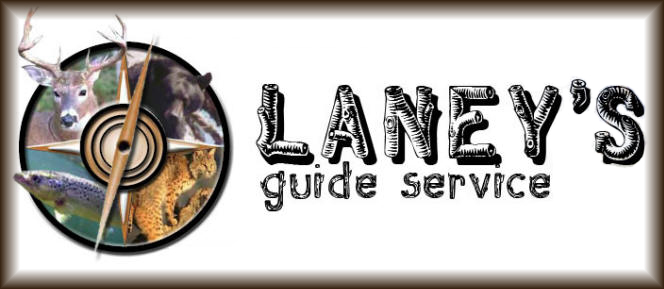This article by veteran Outdoor Writer, Tom Hanrahan, appeared in the March 2004 issue of the
Northwoods Sporting Journal. |
|
Chasing Wild Cats
|
| By Tom Hanrahan |
|
I shot the crouching tomcat and it corkscrewed four feet into the air as if launched from a mortar. I could smell its breath. Shooting it just pissed it off.
The big tom then landed on top of the hounds, howling and screeching like a banshee, biting and scratching and fighting for its life. All I could see was a blur of hair and blood and snow, claws and snapping jaws. I fired again and this time it was all quiet, except for the dogs vigorously mauling the dead cat. They deserved their reward.
It was dusk now and we had chased the cat for two hours through dense brush and six inches of snow far up in northern Maine. My legs were on fire and my lungs were scorched from the frigid air. I collapsed onto the ground and thanked God I was able to make it in time to shoot the caterwauling
|
feline before the dogs killed it. I could not remember ever feeling so exhausted, or so exhilarated.
“That’s about as good as it gets,” said my guide, the 28-year-old wunderkind of cat hunting in Maine, Paul Laney. He let out a whoop like an Indian, We had come to an old honey hole his father first turned him onto when he was a kid, and it had proved to be worth the trip. The cat weighed more than 30 pounds and was 35 inches long. I was happier than a kid at Christmas.
When it was all done we took our bearings and walked out of the woods in the dark. I’ll never forget it as long as I live. Paul dragged the cat with his belt and I followed behind the dogs, all of us weary but ecstatic. |
|
|
Hunting bobcats with hounds in the winter in Maine has become an arcane sport of late. Fewer and fewer practice it. Those who do are getting to be old men. Laney is the sole exception and he is the past, present, and future of cat hunting, descended from famous cat hunters of your and just hitting his prime. He killed 15 cats this winter, despite some terrible conditions.
Be prepared to sweat, that’s what my editor told me when I first decided to go on a cat hunt. Be prepared to die is more like it. I’d been in the gym since the last hunt, 30 minutes a day on the Stairmaster and 100 sit-ups. It wasn’t even close to being enough.
|

|
The dogs – indefatigable Plott hounds named Suzy and Lilly – chase the cat and Paul chases the dogs and I chase Paul. I know what he looks like from behind pretty well now. I can go about a mile before I run out of gas. And from then on I am running on empty, spurred on only by the plaintive wail of the dogs.
My heart starts to pound like a drum and I breathe in great gulps, trying to force enough air into my lungs to keep going. It was so cold this year that my eyelids started to freeze over and my hands ached like they were stuck in a metal vixe. I nearly put my eye out on a broken branch and for a time I felt like I was swimming in slash. I learned
|
|
|
not to eat before we started a chase because I feared I would throw it all up. This is hunting that makes your blood boil and you pay for it in every way a man can suffer. Muscle cramps, bruised flesh, assorted cuts and nicks, sore feet and back, hell, that’s just for starters.
I can’t wait to go again.
It all starts with the ability to read a fresh cat track. Laney and his frequent partner. legendary master Maine guide, Dave Tobey, are sharp-eyed experts. The bobcat track is frequently confused with the track of foxes, coyotes and fisheers, and it takes a keen eye to tell the difference. The bobcat track is neat and tidy and round – they punch neat holes in the snow with a slightly bowlegged gait. Coyotes leave a splashy track and you can draw an X through their toes. The fox always walks in a very straight line and has a foot shaped like an
|
arrowhead. The fisher has five toes and shows his claws. But all of them can change their strut – depending on conditions – and closely mimic the bobcat. Coyotes often walk cautiously when they approach a road and then they can look a lot like a cat. Only years and years of experience make the cat tracker consistently correct in his identification.
We drive hundreds of miles a day – throughout northern and Down East Maine – to find a fresh cat track and Laney is on his Tundra snowmobile for hours when we stop to investigate back woods paths. This year we seldom hunted in temperatures above zero and on many days the temperature was as cold as 30 below. Just because you find a cat track doesn’t mean you are going to get the cat and on a good number of days the cold was enough to knock the scent down to nothing and make the dogs noses ice over. When there
|
|
|
was no new snowfall there were so many old tracks that it was like we were reading a week old newspaper.
But Paul Laney is a man who does not know the meaning of the word quit and when we were having trouble finding cats it just meant we got up earlier in the day. That meant 3 a.m. I’m still catching up on my sleep! Armed with flashlights, we scoured the countryside in his truck, pointing the torches at the side of the road from inside the warm cab.
Three o’clock in the afternoon proved to be the witching hour for big cats and many a chase was started at that hour only to end in frustration, cut off by the darkness. Sometimes we walked for hours and hours through the woods without jumping a cat. I often fell off my snowshoes when we were deep in the woods and had to struggle to get up again, cursing a blue streak. But when the dogs began to bark it was as if I
|
had been infected with adrenaline and found the energy to carry on. Oh, how I prayed to hear those hounds start howling! Sweet, sweet music.
A radio and a GPS, a lighter and firestarter are critical to this hunt. So are good gloves (I recommend mittens for riding the sled) and warm clothing. We often hunted with winds that brought the chill factor to 50 below and friends, this ain’t no joke. I started out with 30-inch Tubbs Altitude aluminum shoes but found they offered insufficient flotation for my 250-pound body. I called company executives Ed Kiniry and his son Dan, both avid Maine hunters and outdoorsmen, and they sent me a pair of their longer wooden floats and I found they worked great. A lot more quiet too. They’re quality snowshoes of the first order and I can’t recommend them highly enough. Thanks Dan and Ed.
|
|
|
You never know when a cat is going to pop out ahead of you and I missed one while standing on a snowmobile trail while Paul and my good friend and master guide Lee Schanz Jr. were running with the hounds. The dogs were quiet and I didn’t have my gun in the ready position. Big mistake. And when Dave Tobey yelled, “There it is!” I shot behind the cat as it crossed the trail and disappeared into the
|

|
bushes.
We got the big tom on the last day of the hunt and in a location known only to the cat hunters of long ago. It was deserted. We walked a beaver flowage and a stream for a while before holding him at bay. There are few experiences in life like coming across a big cat held at bay in the forest by snarling and howling hounds, and it got me so wound up I didn’t sleep for the next three
|
|
|
days. I can still see that cat leaping into the air and twisting like a skyrocket in flight. What a moment!
When it was all done we took our bearings and walked out of the woods in the dark. I’ll never forget it as long as I live. Paul dragged the cat with his belt and I followed behind the dogs, all of us weary but ecstatic. The night a dull blue and the stars starting to shine, the powdery dry snow crunching underneath our boots. We celebrated with cheese and crackers and pepperoni in the cab of Paul’s Chevrolet.
Nothing ever tasted so good.
Last year I shot five cats with Paul and we enjoyed near perfect conditions, deep wet snow and temperatures, well they were pretty cold that year too now that I think about it. But deep snow makes the cat less able to outrun the dogs and makes them jump more. They tire more easily. But I think I
|
learned more this year, and I know I worked a lot harder for the one trophy cat that is now being mounted by Art Fayta in Pownal. I think you appreciate a trophy more when you have to struggle for it, and I thank Paul for waiting for me to catch up to him so I could shoot the big cat. He is the most professional and hardest working guide I have ever hunted with and I can recommend him without reservation.
Laney and Tobey are the kind of Maine Guides that live up to the legend. They’re friendly and fun, dedicated and gifted woodsmen. Tobey has been instrumental in setting aside wilderness in the Grand Lake Stream area for hunters to enjoy in the future and is president of the Maine Professional Guides Association. They’re also two of the very few Maine Guides who earn their living solely by guiding. I’d hire either of them to hunt anything you can chase after in Maine but when it comes
|
|
|
to hunting bobcats, they are among the best in the business. The only two other cat guides I know of who are worthy of the title are Nelson Cole of Thorndike and Bobby Parker of Wilton. Keep in mind when hiring a cat guide that if he doesn’t have good hounds, you’re wasting your time and money.
The best gun for the money is a single-shot 12 gauge. Sooner or later your barrel is going to be clogged with snow, ou can count on it, and the one-shot is the easiest one to check for blockage and to clear. This is a serious safety consideration. I suggest #2 bird shot but Paul moved over this year to a 20-gauge using #4s. Taxidermist Art Fayta goes bananas when I tell him we used a shotgun and suggests a .22 for any and all shots on cat. But Paul says the .22 doesn’t always kill cleanly and can leave a wounded cat to chew up his dogs. I suppose it depends on how good a marksman you are.
|
Paul always uses a Colt Woodsman .22 on cats at bay, but keep in mind this is a potentially tragic situation, where a missed shot can kill a dog or a hunting buddy. Nothing is worth that! It’s difficult to keep a cool head with a trophy cat four feet from your gun, but never shoot until you have a safe shot. And always aim for behind the shoulder. I shot my cat amidships and didn’t kill it. A wounded cat is murder on the dogs. Take your time and take careful aim.
I keep telling myself I will try wearing ski goggles in the thickets but I haven’t actually done so yet. An eye injury is likely when you spend all day bulling through the thick stuff and you can’t dodge every branch, stick and blowdown. Watch caps are a poor choice for headgear because they snag on trees and come off. I recommend a Filson wool hat with ear flaps. The flaps keep your ears warm without drowning out all
|
|
|
the sounds of the woods, including the dogs, and the hat stays put. Lithium batteries last longer in extreme cold and should be your battery of choice for your radio and flashlight and GPS. And most importantly, if you have not been on your snowshoes in a while, get them out and get on them and go! It’s easy to practice for a cat hunt – just find the most impossibly dense thicket around and dive in.
If you’re like me and can’t always keep up with a 28-year-old athlete, make damned sure you know how to get found if you get lost. Paul and Dave have you to leave a hunter stranded in the woods, but they hunt in big woods and frankly this is not a hunt for anyone who is not well versed in big woods navigation. A broken leg or ankle is always a possibility and you want to make sure you can survive over night if it comes to that. Be prepared!
|
As for me, I am already back in the gym on the Stairmaster. This machine helps mimic the up and down stepping that is so common to hunting cats in the woods in winter on the webs. If you want to hunt cats next winter, you need to start now to get in shape for Paul’s marathon chases. You can’t do enough, TRUST ME, My friend Lee Schanz Jr. is a top woodsman and in very good shape and was able to keep up with the fleet-footed Paul but he looked like he’d been through the wringer when he came out at the end of the day. You have been warned.
One additional word of advice. Cat hunting is highly addictive. It gets inside of you and won’t let go. Most people never see a bobcat, let alone shoot one. Once you hunt down a cat, you want another one. And another. You forget about throwing up, about temperatures cold enough to freeze your
|
|
|
nose off and sticks in the eye. All you can think abut is catching up with a monster 40-pounder and killing him. And there’s only two months to do it in!
|
|
Tom Hanrahan is a veteran newspaperman and a Master Maine Guide
|
|






